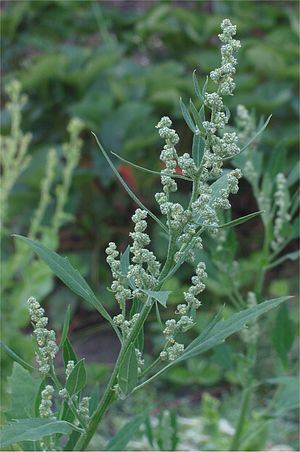シロザ
Chenopodium album/ja
| Chenopodium album/ja | |
|---|---|

| |
| Scientific classification | |
| Kingdom: | Plantae |
| Clade: | Tracheophytes |
| Clade: | Angiosperms |
| Clade: | Eudicots |
| Order: | Caryophyllales |
| Family: | Amaranthaceae |
| Genus: | Chenopodium |
| Species: | album
|
| Binomial name | |
| album | |

| |
| Distribution, from GBIF | |
| Synonyms | |
| |
シロザ(Chenopodium album) は、顕花植物のヒユ科に属する成長の速い一年生植物である。一部の地域では栽培されているが、他の地域では雑草と見なされている。一般的な名称には、ラムズクォーターズ、メルデ、グースフット、ワイルドスピナッチ、ファットヘンなどがあるが、これらのいくつかはアカザ属の他の種にも適用されるため、しばしばホワイトグースフットと区別される。
特徴

本種は当初、直立して生育し、高さは10–150 centimetres (4–59 in)(稀に3 m)に達する。その後、開花後は通常、他の植物に支えられない限り(葉と種の重みで)倒れる傾向がある。葉は互生し、見た目は様々である。株の基部に近い最初の葉は鋸歯があり、およそ菱形で、長さ3-7 cm、幅3-6 cmである。花茎の上部の葉は全縁で披針形菱形、長さ1-5 cm、幅0.4-2 cmである。これらはワックスで覆われ、濡れにくく、粉っぽい外観で、裏面には白い粉状のコーティングがある。小さな花は放射相称で、長さ10-40 cmの密な枝分かれした花序に小さな集散花序として咲く。さらに、花は両性花と雌花であり、外側が粉っぽい5つの花被片を持ち、基部で短く合着している。雄しべは5本である。
類似種
有毒なイヌホオズキは、若い頃は本種に似ているが、C. albumの葉には白い粉状の質感があり、その葉腋には赤い筋がある。
分類
Chenopodium album は複雑な分類を持ち、数多くの小種、亜種、変種に分けられてきたが、それらを区別するのは難しい。以下の変種が『Plants of the World Online』で認められている。
- Chenopodium album var. album – 温帯ユーラシア、インド亜大陸、北アフリカ、エチオピア
- Chenopodium album var. missouriense (アエレン) バセット & クロンプトン(シノニム Chenopodium missouriense アエレン) – アメリカ合衆国東部および中央部
- Chenopodium album var. reticulatum (アエレン) ウオティラ(シノニム Chenopodium reticulatum アエレン) – フランスおよびイギリス
分布と生息地
その自生地は広範な栽培のために不明瞭であるが、ヨーロッパのほとんどの地域を含み、そこからカール・リンネが1753年にこの種を記載した。東アジア原産の植物はC. albumに含まれるが、ヨーロッパの標本とは異なることが多い。『プランツ・オブ・ザ・ワールド・オンライン』によると、この種の自然分布には、西ヨーロッパから中国、ロシア極東までの温帯ユーラシア、インド亜大陸、北アフリカ、エチオピア、米国東部および中央部が含まれる。
その他の地域、例えばアフリカ、オーストララシア、北アメリカ、オセアニアなどにも広く帰化しており、現在では南極を除くほぼすべての場所で、特に荒れ地の窒素が豊富な土壌に生育している。
栽培
地域
この種は、アジアやアフリカでは穀物や野菜作物(ほうれん草の代わりなど)、あるいは飼料として栽培されているが、ヨーロッパや北アメリカでは、ジャガイモ畑などで一般的に雑草と見なされている。一方、オーストラリアではすべての州で帰化しており、ニューサウスウェールズ州、ビクトリア州、西オーストラリア州、ノーザン準州では環境雑草と見なされている。var. albumは米国のいくつかの地域で侵略的と考えられているが、var. missourienseは在来種である。
在来作物への潜在的影響
これは最も丈夫で競争力のある雑草の一つであり、新たな領域を植民地化する能力に非常に優れている。1ヘクタールあたり最大5000万個の種子を生産する可能性があり、その種子は土壌中で30〜40年間生存可能であり、生育環境に応じて成長形態を変化させる高い表現型可塑性を示す。植物が小さい場合は、暗所耕起、ロータリーホーイング、または火炎除草によって防除できる。小粒穀物の輪作は、蔓延を抑制する。多くの土壌処理除草剤で容易に防除できる。その花粉は花粉症のようなアレルギーの一因となることがある。
病害虫対策
Chenopodium album はハモグリバエに弱く、コンパニオンプランツとして有用なおとり作物となる。他の植物の近くで栽培することで、本来保護すべき作物を攻撃する可能性のあるハモグリバエを引き寄せる。テンサイヨコバイの宿主植物であり、この昆虫はテンサイ作物にカーリートップウイルスを媒介する。
用途
栄養
生のラムズクォーターズは、84%が水分、7%が炭水化物、4%がタンパク質、1%が脂肪である。100グラムあたり43キロカロリーを提供し、ビタミンC(96% DV)、ビタミンA(73% DV)、リボフラビン(37% DV)、ビタミンB6(21% DV)、マンガン(37% DV)、カルシウム(31% DV)の豊富な供給源であり(1日当たりの摂取量(DV)の20%以上)、その他のいくつかのミネラルも少量含まれている。
料理用途

若い芽は生で、または調理して食べることができる。葉は調理する方が好ましい。
The flower buds and flowers can also be eaten cooked. Each plant produces tens of thousands of black seeds. Quinoa, a closely related species, is grown specifically for its seeds. The Zuni people cook the young plants' greens.
Archaeologists analysing carbonized plant remains found in storage pits and ovens at Iron Age, Viking Age, and Roman sites in Europe have found its seeds mixed with conventional grains and even inside the stomachs of Danish bog bodies.
In India, the plant is called bathua and is found abundantly in the winter season. The leaves and young shoots of this plant are used in dishes such as soups, curries, and paratha – stuffed breads, common in North India. The seeds or grains are used in phambra, gruel-type dishes in Himachal Pradesh, and in mildly alcoholic fermented beverages such as soora and ghanti. In Haryana state, the "bathue ka raita" i.e. the raita (yogurt accompaniment) made with bathua, is commonly eaten in winters.
In Nepal, it is known as bethe or bethu. It is used to make a dish known as saag. The leaves are stir-fried with spices, chilli and diced garlic. A fermented dish known as masaura is also made by dipping the leaves in a lentil batter with spices and then drying them in sun for some days. The fermented masaura can be made into a curry and served with rice.
Animal feed
As some of the common names suggest, it is also used as feed (both the leaves and the seeds) for chickens and other poultry.
Construction
The juice of this plant is a potent ingredient for a mixture of wall plaster, according to the Samarāṅgaṇa Sūtradhāra, which is a Sanskrit treatise dealing with Śilpaśāstra (Hindu science of art and construction).
Ayurveda
In Ayurveda traditional medicine, bathua is thought to be useful for treating various diseases, although there is no clinical evidence such uses are safe or effective.
External links
 Media related to Chenopodium album at Wikimedia Commons
Media related to Chenopodium album at Wikimedia Commons Data related to Chenopodium album at Wikispecies
Data related to Chenopodium album at Wikispecies
| この記事は、クリエイティブ・コモンズ・表示・継承ライセンス3.0のもとで公表されたウィキペディアの項目Chenopodium album/ja(12 July 2025, at 08:05編集記事参照)を素材として二次利用しています。 Lua error in Module:Itemnumber at line 91: attempt to concatenate local 'qid' (a nil value). |
- Pages with script errors
- Chenopodium
- Flora of Europe
- Flora of temperate Asia
- Flora of the Indian subcontinent
- Flora of North Africa
- Flora of Ethiopia
- Edible nuts and seeds
- Leaf vegetables
- Plants described in 1753
- Plants used in Native American cuisine
- Plants used in traditional African medicine
- Taxa named by Carl Linnaeus

